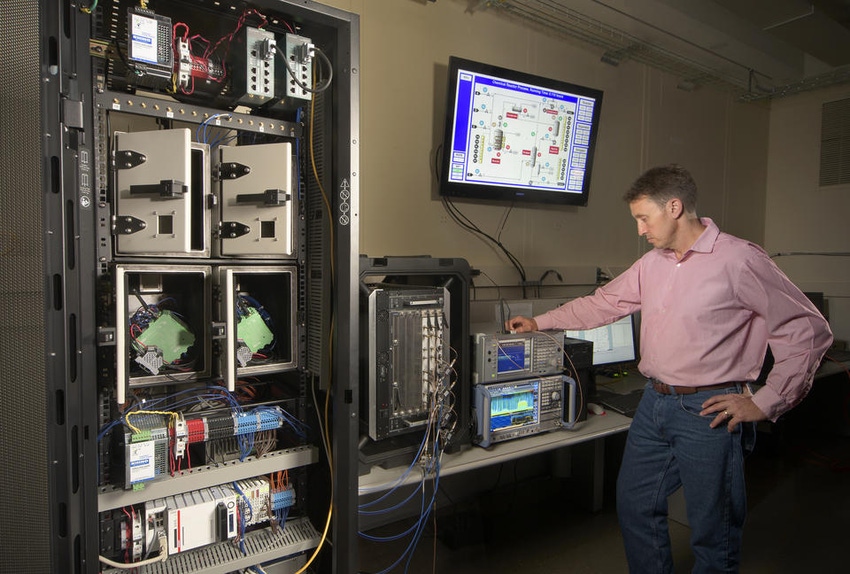Taking Your Factory Wireless? NIST Has You Covered
Through its Wireless Systems for Industrial Environments project, NIST is working with private-sector collaborators and standards organizations to make industrial wireless communication the first choice for factories.
November 8, 2018

In the factory of the near future, networked systems will monitor and direct processes. Machines will communicate with both each other and humans at high speeds. And the factory itself will make choices to optimize and facilitate production. None of this will be possible without reliable wireless communications, however. Recognizing this fact, the National Institute of Standards and Technology (NIST) has published a set of science-based guidelines to help users do the following: choose the best wireless system for any specific industrial environment; customize the setup to make it work; deploy it; and ensure that the network performs as needed.
|
Using a novel testbed that recreates factory environments in the lab, NIST engineer Rick Candell helps “industrial communications networks go wireless by studying how different factory layouts affect wireless radio frequencies. (Image source: Earl Zubkoff) |
Rick Candell, an electronics engineer in NIST’s Engineering Laboratory, spoke to Design News about how this work evolved at NIST, as well as his part in it. Candell, who has a background in wireless technologies for the private sector, had noticed that the selection of wireless technologies for automation is normally driven by who you know on the vendor side (i.e., vendor recommendation). He also noticed that a lot of the people who work on factory floors are typically mechanical engineers. “You might have some electrical or electronics engineers,” noted Candell, “but they’re not wireless experts.”
He continued, “So therein lies the need: How do we help these people in factories and industrial settings, who know their process really well, to understand the wireless domain and make informed choices to select the right technology for their applications? That’s really what the guide is all about.”
Beyond Sensor Networks
“When I first started here,” Candell noted, “I think the wireless sensor network craze was sort of peaking—maybe passing the hype curve. People, mostly in process control, had deployed some of these networks just to be able to collect data from the processes. In factory automation like for automotive and aerospace, wireless was being used--but typically, like in automotive, was being used for PLC connectivity to a back-end server like an automation server or something like that.”
“On the aerospace side, I saw it primarily used, again, for file transfer, but also being able to configure machines and things like that or track parts,” Candell told us. “But there wasn’t a huge push yet for wireless-based control and safety. So I thought, ‘With the advent of robotics and Industry 4.0 and smart manufacturing, where robots need to be mobile and reconfigurable and agile, that right there requires untethered connectivity.’ So we started looking into how wireless technology would impact factory control.”
Candell said, “I’ve been focusing for the last five years, since 2014, on the impact of different networking technologies—both on the cybersecurity and the wireless side. And I’ve been measuring, basically through testbedding and simulation, how that technology impacts factory processes. That kind of measurement experience helped us to inform the guidelines.”
NIST and the Institute of Electrical and Electronics Engineers (IEEE) organized a technical working group of experts on wireless communications from government, industry, and academia to develop the guide. Being a how-to, its goal is to walk the user through the steps needed to arrive at the best wireless fit for his or her individual operation.
At a length of about 50 pages, the guide begins by explaining how wireless technologies and networking operate in basic terms. It also includes a glossary and at-a-glance compendium of RF considerations and technical challenges. The guide’s goal is for a user to be able to do the following: make a business case for wireless; break down the components of a complete wireless life cycle; use wireless to enhance factory safety; protect and secure a wireless network; learn about best wireless practices; and more. A series of best-practice case studies completes the guide, showing what strategies can be used to improve and optimize wireless in different factory scenarios.
According to NIST, future guides will address more advanced communications scenarios, such as wireless technologies for control of mobile and collaborative robotics in the factory. Candell stated, “There are people in automotive and aerospace that are particularly interested in using wireless so that they can easily deploy edge devices in their factory and be able to use robotics systems more effectively. That’s going to require wireless connectivity and wireless control. So the next five years, I’m going to be focusing on developing extensions to the guideline that are more pinpointed to factory automation.”
Download the "Guide to Industrial Wireless Systems Deployments" here and keep an eye out for more resources from NIST.
Nancy Friedrich is Editor-in-Chief and Content Director of Design News. With a 20-year background in covering the electronic and mechanical engineering segments, Nancy has expertise across many areas. At Design News, she focuses on wireless and related areas.
|
About the Author(s)
You May Also Like





